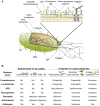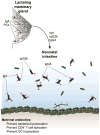IgA Responses to Microbiota
- PMID: 30134201
- PMCID: PMC6107312
- DOI: 10.1016/j.immuni.2018.08.011
IgA Responses to Microbiota
Abstract
Various immune mechanisms are deployed in the mucosa to confront the immense diversity of resident bacteria. A substantial fraction of the commensal microbiota is coated with immunoglobulin A (IgA) antibodies, and recent findings have established the identities of these bacteria under homeostatic and disease conditions. Here we review the current understanding of IgA biology, and present a framework wherein two distinct types of humoral immunity coexist in the gastrointestinal mucosa. Homeostatic IgA responses employ a polyreactive repertoire to bind a broad but taxonomically distinct subset of microbiota. In contrast, mucosal pathogens and vaccines elicit high-affinity, T cell-dependent antibody responses. This model raises fundamental questions including how polyreactive IgA specificities are generated, how these antibodies exert effector functions, and how they exist together with other immune responses during homeostasis and disease.
Copyright © 2018 Elsevier Inc. All rights reserved.
Figures




References
-
- Bakema JE, van Egmond M. The human immunoglobulin A Fc receptor FcalphaRI: a multifaceted regulator of mucosal immunity. Mucosal Immunol. 2011;4:612–624. - PubMed
-
- Barros MD, Porto MH, Leser PG, Grumach AS, Carneiro-Sampaio MM. Study of colostrum of a patient with selective IgA deficiency. Allergol Immunopathol (Madr) 1985;13:331–334. - PubMed
Publication types
MeSH terms
Substances
Grants and funding
LinkOut - more resources
Full Text Sources
Other Literature Sources
Miscellaneous

